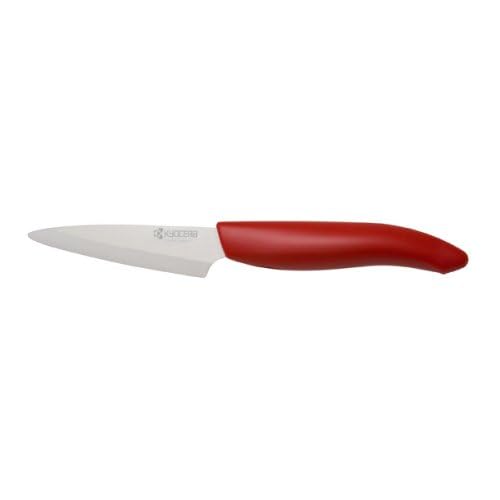Recently, I assigned my mom to bring over a veggie tray for a party we were throwing. She showed up with a bag of vegetables from the store, and a 3" paring ceramic knife. After a short lecture on the proper care of ceramic knives,  she left me use it. Wow.
she left me use it. Wow.

This is the one she brought over. It is very lightweight, and feels like you're using a plastic knife. Supposedly it never dulls, but if it does (or if you ding it) you can return it to Kyocera for a free resharpening ($10 shipping/handling).
Using it was amazing. It feels like a razor's edge. It slices so thinly that you can cut transparent slices of kiwi, tomatos, etc.
Imagine you're slicing a tomato with a serrated knife. When you saw back and forth with the knife, the serrated edge catches the tomato and tears it a little, and your slices have uneven, torn edges. So you switch to a non-serrated knife. When you saw back and forth, the knife doesnt immediately cut into the tomato skin, it takes a couple of saws. So you press down harder and end up mashing the tomato. Using a ceramic knife, it slices into the skin right away, without affecting surrounding areas. I used it to slice kiwis and tomatos and a bunch of soft fruits into perfect, untorn slices of fruit.
Also, because it is non-metallic, it doesn't impart a metallic taste to whatever you're slicing. (Which I've never noticed, but I do notice the the fruit does not brown as from a metal knife)
Caveats: You cant use a ceramic knife to cut into bone. It will break. You cant use it on a metal or marble cutting board (wood or plastic only) You cant use it to pry, it will shatter the brittle tip. It's pricey (about $45 for this paring knife), and the white blade will color with use, and you have to hand wash it. But if you enjoy carving apples into decorative roses, you'll love this knife.
I cant wait to try the peeler to shave fruit. Apparently it works so well that Kyocera gets repeated requests to make a ceramic razor. Their response:
 she left me use it. Wow.
she left me use it. Wow.
This is the one she brought over. It is very lightweight, and feels like you're using a plastic knife. Supposedly it never dulls, but if it does (or if you ding it) you can return it to Kyocera for a free resharpening ($10 shipping/handling).
Using it was amazing. It feels like a razor's edge. It slices so thinly that you can cut transparent slices of kiwi, tomatos, etc.
Imagine you're slicing a tomato with a serrated knife. When you saw back and forth with the knife, the serrated edge catches the tomato and tears it a little, and your slices have uneven, torn edges. So you switch to a non-serrated knife. When you saw back and forth, the knife doesnt immediately cut into the tomato skin, it takes a couple of saws. So you press down harder and end up mashing the tomato. Using a ceramic knife, it slices into the skin right away, without affecting surrounding areas. I used it to slice kiwis and tomatos and a bunch of soft fruits into perfect, untorn slices of fruit.
Also, because it is non-metallic, it doesn't impart a metallic taste to whatever you're slicing. (Which I've never noticed, but I do notice the the fruit does not brown as from a metal knife)
Caveats: You cant use a ceramic knife to cut into bone. It will break. You cant use it on a metal or marble cutting board (wood or plastic only) You cant use it to pry, it will shatter the brittle tip. It's pricey (about $45 for this paring knife), and the white blade will color with use, and you have to hand wash it. But if you enjoy carving apples into decorative roses, you'll love this knife.
I cant wait to try the peeler to shave fruit. Apparently it works so well that Kyocera gets repeated requests to make a ceramic razor. Their response:
Too dangerous! A metal razor blade has a relatively "rounded" edge (under the microscope) which prevents the blade from cutting into the skin. A ceramic razor blade, however, does not have a rounded edge and slices into the skin. Thus, a ceramic shaver would be too dangerous to use. Several engineers in Sendai who tested prototypes can confirm this painful fact!



Comment